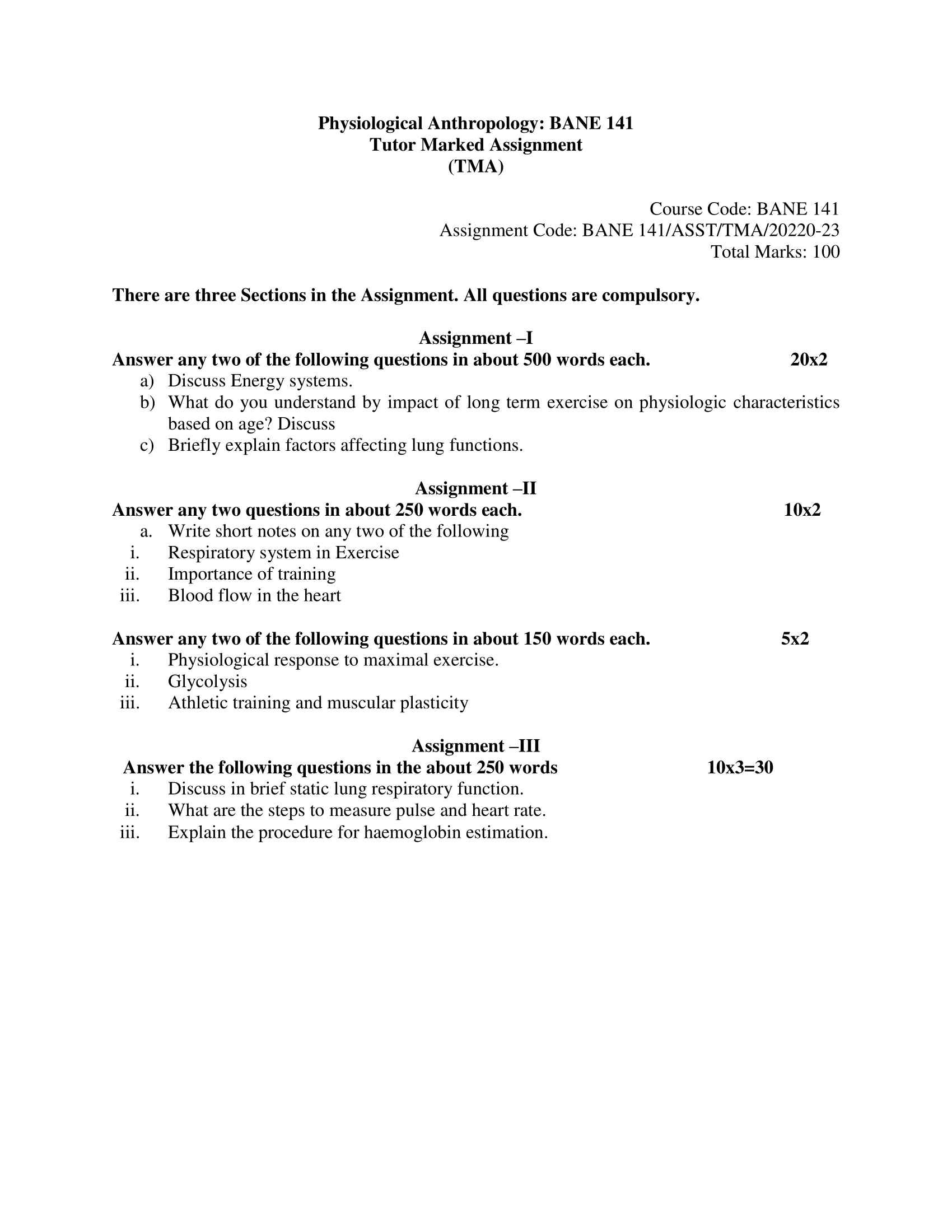Contents
- 1 Assignment –I
- 2 Answer any two of the following questions in about 500 words each. 20×2
- 3 a) Discuss Energy systems.
- 4 b) What do you understand by impact of long term exercise on physiologic characteristics based on age? Discuss
- 5 c) Briefly explain factors affecting lung functions.
- 6 Assignment –II
- 7 Answer any two questions in about 250 words each. 10×2
- 8 a. Write short notes on any two of the following:
- 9 i. Respiratory system in Exercise
- 10 ii. Importance of training
- 11 iii. Blood flow in the heart
- 12 Answer any two of the following questions in about 150 words each. 5×2
- 13 i. Physiological response to maximal exercise.
- 14 ii. Glycolysis
- 15 iii. Athletic training and muscular plasticity
- 16 Assignment –III
- 17 Answer the following questions in the about 250 words. 10×3=30
- 18 i. Discuss in brief static lung respiratory function.
- 19 ii. What are the steps to measure pulse and heart rate.
- 20 iii. Explain the procedure for haemoglobin estimation

| Title | BANE-141: IGNOU BAG Solved Assignment 2022-2023 (Physiological Anthropology) |
| University | IGNOU |
| Degree | Bachelor Degree Programme |
| Course Code | BANE-141 |
| Course Name | Physiological Anthropology |
| Programme Name | Bachelor of Arts (General) |
| Programme Code | BAG |
| Total Marks | 100 |
| Year | 2022-2023 |
| Language | English |
| Assignment Code | BANE 141/ASST/TMA/20220-23 |
| Last Date for Submission of Assignment: | For June Examination: 31st April For December Examination: 30th September |

Assignment –I
Answer any two of the following questions in about 500 words each. 20×2
a) Discuss Energy systems.
Ans: Energy systems refer to the processes by which the body generates and uses energy. There are three main energy systems in the human body: the phosphagen system, the glycolytic system, and the oxidative system. These systems work together to provide the body with the energy it needs to perform various activities.
The phosphagen system is the body’s first line of defense when it comes to generating energy. It is an anaerobic system, which means that it does not require oxygen. This system is used for short-duration, high-intensity activities such as weightlifting, sprinting, or jumping. It operates quickly and provides a rapid burst of energy, but it is limited in duration and cannot sustain energy production for more than a few seconds.
The glycolytic system is the body’s next line of defense when it comes to generating energy. It is also anaerobic, but it can sustain energy production for a longer duration than the phosphagen system. This system is used for activities that last between 30 seconds and two minutes, such as middle-distance running, cycling, or rowing. The glycolytic system operates by breaking down glucose into lactic acid, which is then used to produce energy.
The oxidative system is the body’s most important energy system. It is aerobic, meaning that it requires oxygen to operate. This system is used for activities that last longer than two minutes, such as long-distance running, cycling, or swimming. The oxidative system operates by breaking down glucose and fatty acids into carbon dioxide and water, which are then used to produce energy. This system is the body’s most efficient energy system, but it takes a while to get going, so it is not suitable for high-intensity activities.
There are a number of factors that can influence the body’s energy systems, including age, diet, and training. Younger individuals tend to have a greater ability to access the phosphagen and glycolytic systems, while older individuals tend to rely more on the oxidative system. Diet can also have a significant impact on energy systems, as different nutrients are needed to fuel each system. Training can also impact energy systems, as specific types of training can improve the body’s ability to access different energy systems.
b) What do you understand by impact of long term exercise on physiologic characteristics based on age? Discuss
Ans: The impact of long-term exercise on physiologic characteristics based on age is a complex issue, as the effects of exercise can vary greatly depending on a number of factors, including age, sex, genetics, and overall health. However, in general, long-term exercise has been shown to have a positive impact on various physiologic characteristics, regardless of age.
In young individuals, long-term exercise has been shown to improve cardiovascular health, increase muscle mass and strength, and improve flexibility and range of motion. For example, regular exercise has been shown to increase the size and efficiency of the heart, which can lead to improved cardiac function and a reduced risk of heart disease. Exercise has also been shown to increase muscle mass, which can help to reduce the risk of sarcopenia (age-related muscle loss), and improve overall strength and power. Additionally, exercise has been shown to improve flexibility and range of motion, which can help to reduce the risk of injury and improve overall mobility.
In older individuals, long-term exercise has been shown to have similar benefits, but may also have additional benefits specific to this age group. For example, long-term exercise has been shown to improve cognitive function and reduce the risk of age-related declines in memory and other cognitive skills. Exercise has also been shown to improve balance and reduce the risk of falls, which are a major cause of injury and disability in older individuals. Additionally, long-term exercise has been shown to improve bone density, which can reduce the risk of osteoporosis and fractures.
It is important to note that while the positive effects of exercise are well established, there are also potential negative effects that should be considered. For example, over-exercise can lead to injury, muscle imbalances, and decreased athletic performance. Additionally, exercise that is too intense or performed without proper rest and recovery can result in decreased muscle mass, increased risk of injury, and decreased overall performance.
Overall, the impact of long-term exercise on physiologic characteristics based on age is complex and dependent on a number of factors. However, in general, exercise has been shown to have a positive impact on various physiologic characteristics, regardless of age. To maximize the positive effects of exercise, it is important to engage in regular physical activity that is appropriately designed to meet individual needs and goals, and to ensure that exercise is performed in a safe and responsible manner.
c) Briefly explain factors affecting lung functions.
Ans: Lung function is an essential aspect of human health, as the lungs are responsible for supplying the body with oxygen and removing carbon dioxide. However, lung function can be affected by a variety of factors, some of which are within our control and others that are not. Understanding these factors can help individuals to better understand their own lung function and take steps to maintain or improve their respiratory health.
One of the most important factors affecting lung function is age. As individuals age, lung function naturally declines, which can lead to decreased oxygen exchange and increased risk of respiratory disease. This decline in lung function can be exacerbated by factors such as smoking, exposure to air pollution, and a sedentary lifestyle.
Another factor affecting lung function is smoking. Smoking is one of the leading causes of lung damage and is responsible for a wide range of respiratory problems, including chronic bronchitis, emphysema, and lung cancer. Smoking can cause structural damage to the lungs, which can result in decreased lung function and increased risk of respiratory disease.
Air pollution is another factor that can affect lung function. Exposure to air pollution, especially over long periods of time, can lead to decreased lung function and increased risk of respiratory disease. Air pollution can cause inflammation in the airways, leading to bronchitis, asthma, and other respiratory problems. Additionally, air pollution can cause oxidative stress, which can damage lung cells and result in decreased lung function.
Occupational exposure to pollutants can also have a significant impact on lung function. Individuals who work in industries that involve exposure to pollutants, such as coal mining, oil drilling, and manufacturing, are at an increased risk of respiratory problems due to the exposure to dusts, fumes, and other toxic substances.
Lifestyle factors, such as physical activity and diet, can also affect lung function. Physical activity has been shown to improve lung function by increasing the strength of the respiratory muscles, which can improve oxygen exchange and overall respiratory health. In addition, a healthy diet that is rich in antioxidants, such as fruits and vegetables, can help to protect against oxidative stress and reduce the risk of respiratory problems.
Assignment –II
Answer any two questions in about 250 words each. 10×2
a. Write short notes on any two of the following:
i. Respiratory system in Exercise
Ans: The respiratory system plays a critical role in supporting physical activity and exercise. During exercise, the body’s demand for oxygen increases as the muscles work harder to generate more energy. The respiratory system must work in concert with the cardiovascular system to supply the body with the oxygen it needs and remove the carbon dioxide produced during metabolism.
The primary function of the respiratory system during exercise is to increase ventilation, or the amount of air inhaled and exhaled, to meet the body’s increased demand for oxygen. This is achieved through a combination of increased tidal volume, or the amount of air inhaled with each breath, and increased breathing rate. As exercise intensity increases, so does the rate of ventilation, which helps to maintain oxygen saturation in the blood and support energy production.
In addition to increasing ventilation, the respiratory system also plays a role in regulating blood pH during exercise. As the muscles produce more lactic acid during exercise, the blood becomes more acidic. The respiratory system helps to regulate blood pH by removing excess carbon dioxide, which helps to neutralize the acidity of the blood.
In individuals with respiratory conditions, such as asthma or chronic obstructive pulmonary disease (COPD), exercise can be challenging due to the increased demand for oxygen and the potential for airway narrowing or other respiratory symptoms. These individuals may require the use of inhaled medications, such as bronchodilators, or other interventions to manage their symptoms and support safe and effective physical activity.
ii. Importance of training
Ans: Training is a critical component of personal and professional development, as it provides individuals with the skills, knowledge, and experience needed to succeed in their personal and professional lives. Training can help individuals to develop new skills, improve existing ones, and adapt to changes in their work environment.
One of the key benefits of training is the improvement of job performance. Through training, individuals can learn about new technologies, processes, and best practices that can help them to perform their job more effectively. This can result in increased productivity, efficiency, and job satisfaction, and can also lead to career advancement and increased earning potential.
Training can also help individuals to develop new skills and knowledge that can support their personal growth and development. For example, training in leadership, communication, or time management can help individuals to improve their personal and professional relationships and achieve their personal and professional goals.
In addition to supporting personal and professional development, training can also improve organizational performance. Through training, organizations can develop a highly skilled and knowledgeable workforce, which can result in increased efficiency, productivity, and competitiveness.
Another benefit of training is that it can improve employee morale and job satisfaction. When individuals receive training, they feel valued and appreciated, which can lead to increased engagement and motivation in their work. This can result in lower levels of stress, turnover, and absenteeism, and can contribute to a positive workplace culture.
iii. Blood flow in the heart
Ans: Blood flow in the heart is a complex and dynamic process that plays a critical role in maintaining cardiovascular health. The heart is responsible for pumping blood throughout the body, and this process is achieved through the coordinated contraction and relaxation of the heart chambers, known as the systole and diastole phases, respectively.
During the systole phase, the heart contracts and pumps blood from the left ventricle into the aorta and from the right ventricle into the pulmonary artery. The blood then flows through the body’s circulatory system, supplying the body with oxygen and nutrients, and carrying away waste products.
During the diastole phase, the heart relaxes and fills with blood that has returned to the heart through the veins. This blood is then ready to be pumped out during the next systole phase. The flow of blood in and out of the heart is regulated by the heart’s electrical system, which generates electrical impulses that control the contraction and relaxation of the heart chambers.
In order to maintain proper blood flow in the heart, it is important to maintain a healthy lifestyle. This includes eating a balanced diet, exercising regularly, not smoking, and managing stress levels. Chronic conditions, such as high blood pressure, obesity, and diabetes, can negatively impact blood flow in the heart and increase the risk of cardiovascular disease.
In addition to lifestyle factors, the blood flow in the heart can be impacted by medical conditions, such as heart disease, heart valve problems, and arrhythmias. These conditions can cause blockages or obstructions in the blood vessels, leading to decreased blood flow and increased risk of cardiovascular events, such as heart attack or stroke.
Answer any two of the following questions in about 150 words each. 5×2
i. Physiological response to maximal exercise.
Ans: The physiological response to maximal exercise is a complex and coordinated process that involves multiple systems in the body. During maximal exercise, the body experiences a range of physiological changes in response to the increased demands placed on the cardiovascular, respiratory, and muscular systems.
One of the most significant physiological responses to maximal exercise is an increase in heart rate and cardiac output, which is necessary to deliver oxygen and nutrients to the working muscles. At the same time, the body experiences an increase in respiratory rate and tidal volume, which helps to increase the delivery of oxygen to the muscles and support energy production.
The muscles themselves also undergo a range of physiological changes during maximal exercise, including an increase in the release of energy substrates, such as glucose and fatty acids, and an increase in the production of lactic acid. These changes are necessary to support energy production and maintain muscle function during intense exercise.
In addition to these physiological responses, the body also experiences changes in hormone levels, such as increased adrenaline and noradrenaline, which help to regulate energy metabolism and support performance.
Overall, the physiological response to maximal exercise is a complex and dynamic process that involves the coordinated effort of multiple systems in the body. By understanding the physiological changes that occur during maximal exercise, individuals can better understand the demands placed on the body and support their training and performance goals.
ii. Glycolysis
Ans: Glycolysis is the metabolic process by which the body converts glucose, a type of sugar, into energy. This process takes place in the cytoplasm of cells and is the first step in the breakdown of glucose for energy production.
During glycolysis, glucose is broken down into two molecules of pyruvate, releasing energy in the process. This energy is then used by the cells to produce ATP, the molecule that serves as the body’s main source of energy.
Glycolysis can occur in the presence or absence of oxygen, making it an important process for both aerobic and anaerobic energy production. When oxygen is present, the pyruvate produced during glycolysis is further broken down in the mitochondria, leading to the production of more ATP. When oxygen is not present, the pyruvate is converted into lactic acid, which can be used by the muscles for energy production.
In addition to its role in energy production, glycolysis also plays a key role in regulating blood sugar levels and supporting cell growth and division. By understanding the process of glycolysis, individuals can gain a deeper understanding of the body’s energy metabolism and the importance of maintaining a balanced diet for overall health and well-being.
iii. Athletic training and muscular plasticity
Ans: Athletic training and muscular plasticity are closely related concepts that refer to the ability of the muscles to adapt and change in response to physical activity. Regular athletic training can induce changes in the structure and function of the muscles, leading to improved athletic performance.
One of the key mechanisms underlying muscular plasticity is an increase in the number of muscle fibers, known as hypertrophy. This can lead to an increase in muscle strength and power, which can be beneficial for athletes. Additionally, athletic training can also lead to an increase in the efficiency of energy production in the muscles, allowing for improved endurance and reduced fatigue during exercise.
Another important aspect of muscular plasticity is the development of neural adaptations, such as improved coordination and muscle activation patterns. These adaptations can help athletes to perform movements more efficiently and effectively, leading to improved performance.
Overall, athletic training and muscular plasticity are important components of athletic performance. By inducing changes in the structure and function of the muscles, regular athletic training can support the development of physical attributes, such as strength, power, and endurance, that are critical for success in sports and physical activity.
Assignment –III
Answer the following questions in the about 250 words. 10×3=30
i. Discuss in brief static lung respiratory function.
Ans: Static lung respiratory function refers to the ability of the lungs to maintain a stable volume of air during quiet breathing. This function is critical for ensuring proper oxygenation of the blood and maintaining a stable breathing pattern.
The static lung functions can be evaluated through several measures, including vital capacity, residual volume, and total lung capacity. Vital capacity refers to the maximum amount of air that can be exhaled after a maximum inhalation, while residual volume is the amount of air remaining in the lungs after a maximum exhalation. Total lung capacity is the sum of these two volumes and reflects the overall size of the lungs.
Several factors can influence static lung respiratory function, including age, gender, physical activity, and lung disease. For example, age-related changes, such as a decline in lung elasticity, can lead to a decrease in vital capacity and total lung capacity. Similarly, physical inactivity and a sedentary lifestyle can also reduce lung function over time.
Lung diseases, such as chronic obstructive pulmonary disease (COPD), can also have a significant impact on static lung function. COPD is characterized by an irreversible decline in lung function, leading to increased difficulty breathing and a reduction in vital capacity and total lung capacity.
ii. What are the steps to measure pulse and heart rate.
Ans: Measuring pulse and heart rate is a simple and non-invasive way to assess the health of the cardiovascular system. The following are the steps to measure pulse and heart rate:
- Find the pulse: The pulse can be found in various locations, including the wrist, neck, and temples. To find the pulse in the wrist, place your index and middle fingers over the radial artery, which runs along the thumb side of the wrist. To find the pulse in the neck, place your fingers over the carotid artery, which is located in the neck just below the jawline.
- Count the beats: Once you have found the pulse, count the number of beats for 15 seconds and then multiply the number by four to get the beats per minute (bpm). This is your heart rate.
- Use a heart rate monitor: Another option to measure heart rate is to use a heart rate monitor. This device measures the electrical signals generated by the heart and displays the heart rate in bpm.
- Take multiple readings: It’s important to take multiple readings to ensure accuracy and to account for any fluctuations in heart rate. Record the heart rate and pulse for each reading and compare the results.
- Evaluate the results: A normal resting heart rate for adults is 60 to 100 bpm. However, heart rate can vary depending on factors such as age, physical activity level, and overall health. It’s important to consult a healthcare provider if you have concerns about your heart rate or pulse.
iii. Explain the procedure for haemoglobin estimation
Ans: Haemoglobin estimation is a laboratory test that measures the amount of haemoglobin in the blood. Haemoglobin is a protein found in red blood cells that carries oxygen from the lungs to the rest of the body. Low levels of haemoglobin can indicate anemia, while high levels can suggest other conditions such as dehydration or kidney disease.
There are several methods for haemoglobin estimation, including:
- Hemoglobinometer: A hemoglobinometer is a small, portable device that measures haemoglobin levels using a sample of blood. This method is quick and easy, but can be less accurate than other methods.
- Complete Blood Count (CBC): A CBC is a commonly used blood test that includes haemoglobin estimation. In this method, a sample of blood is taken and sent to a laboratory for analysis. The laboratory uses a machine called a hematology analyzer to measure the amount of haemoglobin in the blood sample.
- Cyanmethaemoglobin method: This method involves adding a reagent, such as cyanide, to the blood sample to form a complex with haemoglobin. The amount of haemoglobin in the blood sample can then be determined based on the intensity of the resulting color.
- Spectrophotometry: This method uses a spectrophotometer to measure the amount of light absorbed by the blood sample. Haemoglobin levels can be estimated based on the amount of light absorbed.
Regardless of the method used, it is important to ensure that the blood sample is taken and handled properly to ensure accurate results. The procedure for haemoglobin estimation typically involves collecting a small sample of blood, usually from a vein in the arm, and sending the sample to a laboratory for analysis.
How to Download BANE-141 Solved Assignment?
You can download it from the www.edukar.in, they have a big database for all the IGNOU solved assignments.
Is the BANE-141 Assignment Free?
Yes this is absolutely free to download the solved assignment from www.edukar.in
What is the last submission date for BANE-141 Assignment?
For June Examination: 31st April, For December Examination: 30th October















